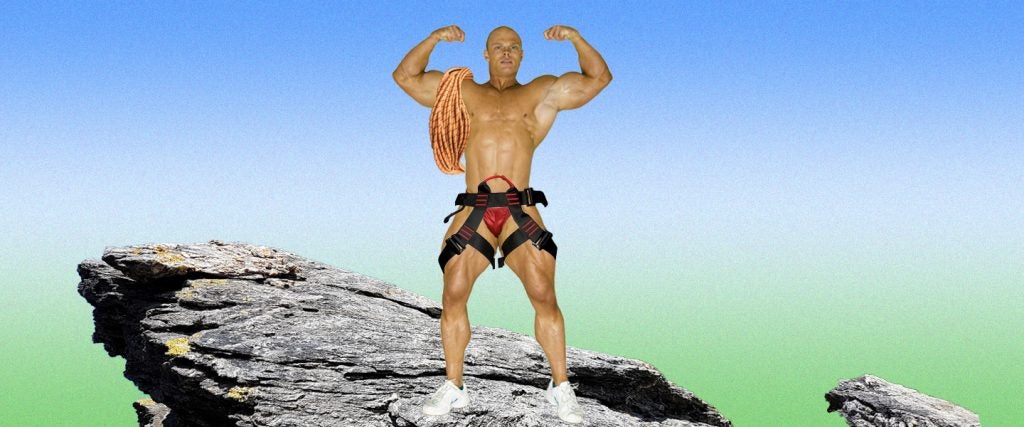Among the unlikeliest places my physical prowess was ever put to the test was when I was asked to chaperone middle school kids during a winter church retreat. The weekend excursion was hosted at a Northern Michigan ski lodge, and the description of my duties made it sound like my actual load of responsibilities would be extremely low, leaving me with plenty of time to play cards with the other chaperones.
On night one, everyone on the grounds was invited to a recreation building, which, among other things, possessed a rock-climbing wall. I was reluctant to engage with it at first, but after watching dozens of people fail miserably to reach the top, I decided that I couldn’t possibly do any worse. In that respect, I was correct, but my climbing pace was far from perfect, and the post-climb pain in my fingers and forearms was absolutely agonizing.
No sooner had I returned to earth when one of the other chaperones — a 5-foot-5 kid with a slender build — scurried up the wall with blinding speed, and without the reassuring security of the protective harness. When he just as effortlessly returned to the ground, I wasted no time before expressing my admiration for his impressive feat. “That was amazing!” I remarked. “You looked like Spider-Man up there!”
“I go to the climbing wall all the time,” the kid shrugged. “This wall isn’t even that difficult.”
All of which is to say that I left the retreat with a newfound respect for people who participate in mountain climbing. I may have thought my large-muscle-group approach to training had left me without any significant weaknesses in my body, but two brief minutes on a climbing wall was all it took to diagnose several areas in which I was severely lacking strength and endurance. No amount of deadlifts, pull-ups and bicep curls had prepared my fingers and forearms for the remorseless onslaught of that wall.
Is mountain climbing a secret hack for major strength gains?
Let’s make sure we’re talking about the same thing: We’re not talking about the horizontal exercises commonly referred to as “mountain climbers,” which train most of your major muscle groups in a plyometric fashion. We’re talking about the stuff Sylvester Stallone was doing in Cliffhanger, which is often referred to as “rock climbing” in order to differentiate it from other training methods.
In terms of the latter, when reviewing the aggregated results of several different studies that assessed the physical benefits of rock climbing as a recreational training method, researchers found statistically significant improvements in the following categories: VO₂ max, handgrip strength, lower limb pedaling power, vertical jump, push-ups, sit-ups and sit-and-reach, with large improvements evident in most of the measures linked with upper-body strength. The areas in which there were no significant improvements were in body fat percentage and heart rate.
Wow. So it sounds like I can replace all of my weight training with rock climbing. It fixes everything!
I see why that would be an attractive conclusion to jump to, but before you get out your jump-to-conclusions mat and start hopping around, let’s take a look at some additional data points.
Researchers also analyzed the physiques of world-class rock climbers and unveiled the traits that seemed to predominate amongst real-life spider men. Their findings identified strong fingers, strong forearms, low body fat percentages and relatively low body weights as nearly universal traits.
Taken in concert with the findings from the other study, we can extrapolate a few things: Since mountain climbing isn’t great at raising heart rates or lowering body fat percentages in and of itself, these are characteristics that the climbers are controlling through other means, like diet and other exercises. Second, mountain climbing itself seems to favor individuals who keep their body weights low, meaning there is a built-in optimization point between muscle strength and body weight.
To make a long story short, your muscles are only going to get so jacked if you exclusively rock climb, and if you think the mass you amass away from the wall is going to translate directly into performance improvements on the wall, that’s unlikely as well. The rock wall doesn’t seem to discriminate between muscle mass and fat mass; it appears to rebuff bulky bodies without any differentiation.
So what should I be using the rock wall for?
For fun, primarily. Or if you actually want to climb mountains, it’s difficult to imagine a safer training regimen that still requires someone to extend a literal lifeline to you, albeit a lifeline that’s more comfortably accepted at 100 feet as opposed to 20,000.
If you feel no compulsion to pursue humongous muscles — except for potentially brandishing forearms of Popeye-level disproportionality — but you’re hoping to construct a physique capable of handling most of what the real world can throw at you, it would be difficult to argue with rock climbing as a form of training. I’m sure many men would prefer to possess sufficient strength to run through a wall, but being able to climb over one is just as impressive — and just as heroic.

